Rajasthan Board RBSE Class 12 Physics Chapter 17 Electromagnetic Waves Communication and Contemporary Physics
RBSE Class 12 Physics Chapter 17 Text Book Exercise with Answers
RBSE Class 12 Physics Chapter 17 Multiple Choice Type Questions
Question 1.
Average energy density radiated in electromagnetic wave is related to :
(a) Only electric field
(b) Only magnetic field
(c) Both electric and magnetic field
(d) Average energy density is zero
Answer:
(c) Both electric and magnetic field
Question 2.
Waves related to telecommunication are :
(a) infrared
(b) visible light
(c) microwaves
(d) ultraviolet ray
Answer:
(c) microwaves
Question 3.
Electromagnetic waves does not possess :
(a) energy
(b) charge
(c) momentum
(d) information
Answer:
(a) energy
Question 4.
If \(\vec{E}\) and \(\vec{B}\) are electric and magnetic field vectors of electromagnetic waves, then the propagation of electromagnetic wave is along :
(a) \(\vec{E}\)
(b) \(\vec{B}\)
(c) \(\vec{E} \times \vec{B}\)
(d) \(\vec{E} \cdot \vec{B}\)
Answer:
(c) \(\vec{E} \times \vec{B}\)
Question 5.
Which radiation has least wavelength?
(a) X-ray
(b) γ-ray
(c) β-ray
(d) α-ray
Answer:
(b) γ-ray
Question 6.
Mark the wrong option related to characteristic of electromagnetic waves :
(a) Both electric field vector and magnetic field occupy maximum and minimum value at same time and position.
(b) In electromagnetic waves, the energy is equally distributed among electric and magnetic field vectors.
(c) Electric and magnetic field vectors are parallel to each and they are perpendicular to the direction other propagation of the wave.
(d) They do not require any medium for their propagation.
Answer:
(c) Electric and magnetic field vectors are parallel to each and they are perpendicular to the direction other propagation of the wave.
Question 7.
For whom the ground waves are possible?
(a) Low radio frequency at low range
(b) High radio frequency at low range
(c) Low radio frequency at high range
(d) Low radio frequency at low range
Answer:
(a) Low radio frequency at low range
Question 8.
The height of a TV tower is h meter. If radius of the Earth is R, then during TV transmission, the area occupied is (if h < R):
(a) πR2
(b) πh2
(c) 2πRh
(d) πRh
Answer:
(c) 2πRh
Question 9.
For propagation of radiowaves the mode used is/are :
(a) Ground wave propagation
(b) Sky wave propagation
(c) Space wave propagation
(d) All of the above
Answer:
(d) All of the above
Question 10.
In an amplitude modulated wave the maximum amplitude is 10 V and minimum amplitude is 2V. The modulation factor m is :
(a) 2/3
(b) 1/3
(c) 3/4
(d) 1/5
Answer:
(a) 2/3
Question 11.
Modulation factor of over modulated wave is
(a) 1
(b) zero
(c) < 1
(d) > 1
Answer:
(d) > 1
RBSE Class 12 Physics Chapter 17 Very Short Answer Type Questions
Question 1.
What is the speed of the electromagnetic waves in vacuum?
Answer:
Velocity of light c = 3 × 108 m/s.
Question 2.
For electromagnetic waves, what is the effect on refractive index of Ionosphere on increasing height from Earth’s surface?
Answer:
Refractive index decreases.
Question 3.
The vibration of \(\vec{E}\) of an electromagnetic wave propagating in X-direction are parallel to Y-axis. Then in which axis vibration of \(\vec{B}\) are parallel?
Answer:
Parallel to Z-axis.
Question 4.
For long distance propagation, which method is used for propagation?
Answer:
Sky wave propagation.
Question 5.
What are the frequency limits for sky waves in sending signal to remote places?
Answer:
Radiowaves of frequency 1.5 MHz to 30 MHz.
Question 6.
Name the part of the communication system which converts signal for propagation to send on communication channel to receiver.
Answer:
Transmitter.
Question 7.
Name the method used to superimpose signal on carrier wave?
Answer:
Modulation.
Question 8.
Which types of matter are studied in Nanotechnology?
Answer:
Below 100 nm.
RBSE Class 12 Physics Chapter 17 Short Answer Type Questions
Question 1.
Name the components of electromagnetic spectrum in decreasing order of wavelength.
Answer:
The electromagnetic spectrum is generally divided into seven regions, in order of decreasing wavelength :
- Radiowaves (103 m)
- Microwaves (10-2 m)
- Infrared rays (10-5 m)
- Visible rays (0.5 × 10-6 m)
- Ultraviolet rays (~ 10-8 m)
- X-rays (~ 10-10 m)
- Gamma rays (~ 10-12 m).
Question 2.
Write four main characteristics of electromagnetic waves.
Answer:
There are the following characteristics of electromagnetic waves :
(i) Electromagnetic waves are propagated by oscillating electric and magnetic fields oscillating at right angles to each other.
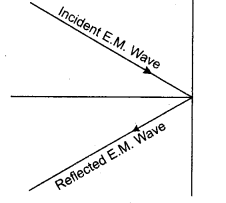
(ii) Electromagnetic waves travel with a constant velocity of 3 × 10-8 ms-1 in vacuum.
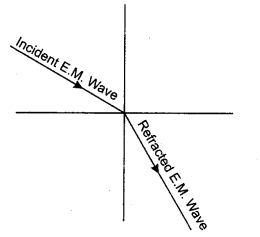
(iii) Electromagnetic waves are not deflected by electric or magnetic field.
(iv) Electromagnetic waves can show reflection and refraction just like the light waves.
When e.m waves strike to the source of conducting material, they are reflected back as shown in the given diagram.
When e.m waves enters from one medium to another, it bends towards the normal or away from normal while travelling in next medium.
Question 3.
Explain ground waves and sky waves.
Answer:
A radio signal emitted from a certain place on the Earth can be received at another location in two possible ways :
- If wave travels directly along the Earth from one point to another is called ground wave.
- If the wave is directed towards the sky and after reflection from ionosphere of Earth’s atmosphere reaches the desired location on Earth is called sky wave.
Question 4.
What is communication system?
Answer:
A communication system is a way of transfering information from one source to another.
The information signals that are mostly used in communication are electrical in nature. The basic components of communication system are :
- Transmitter of information signal
- Carrier of signal
- Receiver of signal
Question 5.
Name the parts of the communication system.
Answer:
There are three essential parts of any communication system :
(i) Transmitter
(ii) Transmission channel
(iii) Receiver.
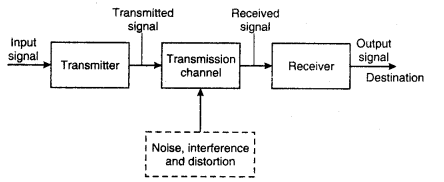
Question 6.
Explain modulation.
Answer:
Modulation is a process through which audio, video, image or text information is added to an electrical or optical carrier signal to be transmitted over a telecommunication or electronic medium. Modulation enables the transfer of information on an electrical signal to a receiving device that demodulates the signal to extract the blended information.
Question 7.
Give the name of the instruments used to observe nanostructures.
Answer:
Nanotechnology made possible because of the instruments used to see things on the nanoscale. Some instruments are :
- Optical microscope
- Electron microscope
- Scanning probe microscope
- Atomic force microscope
RBSE Class 12 Physics Chapter 17 Long Answer Type Questions
Question 1.
What is the nature of electromagnetic wave? Explain the Hertz’s experiment related to electromagnetic wave.
Answer:
Nature of Electromagnetic Waves and Propagation : It can be shown from Maxwell’s equations that electric and magnetic fields in an electromagnetic wave are perpendicular to each other and to the direction of propagation. It appears reasonable, say from our discussion of the displacement current. B and E are perpendicular to each other. In figure 17.4, we show a typical example of a plane electromagnetic wave propagating along the X-direction (the fields are shown as a function of the Y-coordinate, at a given time t). The electric field Ey is along the y-axis, and varies sinusoidally with y, at a given time. The magnetic field Bz is along the X-axis, and again, varies sinusoidally with X. The electric and magnetic fields Ex and By are perpendicular to each other, and to the direction Z of propagation. We can write Ey and Bz as follows :
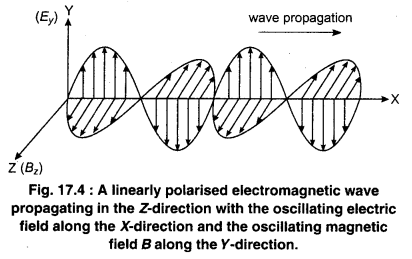
Ey – E0 sin(kx – cωf) …………… (1)
Bz = B0 sin(kx – ωt) ………….. (2)
Here k is related to the wavelength λ of the wave by the usual equation k = 2π/λ and ω is the angular frequency, k is the magnitude of the wave vector (or propagation vector) \(\vec{k}\) and its direction describes the direction of propagation of the wave. The speed of propagation of the wave is (ω / k) using equation (1) and (2) for Ey and Bz and Maxwell’s equation, one finds that
c. = \(\frac{\omega}{k}\) where, c = \(\frac{1}{\sqrt{\mu_{0} \varepsilon_{0}}}\) …………………. (3)
The relation ω = ck is the standard one for waves. This relation is often written in terms of frequency v(= λ/ 2π) and wavelength (λ = 2π/k) as
2πv = \(c\left(\frac{2 \pi}{\lambda}\right)\)
or vλ = c
It is also seen from Maxwell’s equations that the magnitude of the electric and magnetic fields in an electromagnetic wave are related as
B0 = E0/c ………….. (4)
and Em = cBm …………… (5)
If electromagnetic wave propagated in any medium other than vacuum, then speed of light is given by :
\(=\frac{1}{\sqrt{\mu \varepsilon}}=\frac{c}{\sqrt{\mu_{r} \varepsilon_{r}}}\) ……………….. (6)
Where ε is permittivity of the medium and p is the permeability of the magnetic field. εr is relative permittivity and μr. is the relative permeability of the medium. This equation can be written as
v = \(\frac{c}{n}\) ……………. (7)
where, n = \(\sqrt{\mu_{r} \varepsilon_{r}}\) is refractive index of the medium.
Hertz Experiment of Electromagnetic Waves
The existence of electromagnetic wave was confirmed experimentally by Hertz in 1888. This experiment is based on the fact that an oscillating electric charge radiates electromagnetic waves. The energy of these waves is due to kinetic energy of the oscillating charge.
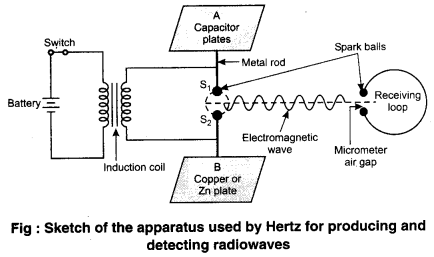
The experiment arrangement is as shown in figure. It consists of two metal plates A and B placed at a distance of 60 cm from each other. The metal plates are connected to two polished metal spheres S1 and S2 by means of metal rods. Using an induction coil a high potential difference is applied across the small gap between the spheres.
Due to high potential difference across S1 and S2, the air in small gap between the spheres get ionized and provides a path for the discharge of the plates. A spark is produced between S1 and S2 and electromagnetic waves of high frequency radiated.
Hertz was able to produce electromagnetic waves of frequency about 5 × 107 Hz.
Here the plates A and B acts an a capacitor having small capacitance value C and connecting wire provide low inductance L. Thus the plates and the rods (with spheres) constitute an LC combination. The high frequency oscillation of charges between the plates is given by
v = \(\frac{1}{2 \pi \sqrt{L C}}\)
Wavelength of the electromagnetic produced is given by

An open metallic ring of diameter 0.70 m having small metallic spheres acts as a detector. This constitutes another LC combination whose frequency can be varied by varying its diameter.
Question 2.
Describe various components of electromagnetic wave and explain their characteristics.
Answer:
Electromagnetic Spectrum
At the time Maxwell predicted the existence of electromagnetic waves were the visible light waves. The existence of ultraviolet and infrared waves was barely established. By the end of the nineteenth century, X-rays and gamma rays had also been discovered. We now know that, electromagnetic waves include visible light waves, X-rays, gamma rays, radio-waves, microwaves, ultraviolet and infrared waves. The classification of electromagnetic waves according to frequency is the electromagnetic spectrum. There is no sharp division between one kind of wave and the next. The classification is based roughly on how the waves are produced and/or detected.
We briefly describe these different types of electromagnetic waves, in order of decreasing wavelengths.
Radiowaves
Radiowaves are produced by the accelerated motion of charges in conducting wires. They are used in radio and television communication systems. They are generally in the frequency range from 500 kHz to about 1000 MHz. The AM (amplitude modulated) band is from 530 kHz to 1710 kHz. Higher frequencies upto 54 MHz are used for short wavebands. TV waves range from 54 MHz to 890 MHz. The FM (frequency modulated) radio band extends from 88 MHz to 108 MHz. Cellular phones use radiowaves to transmit voice communication in the ultrahigh frequency (UHF) band.
Microwaves
Microwaves [short wavelength radiowaves (λ = 0.001m to 0.1m) with frequency in the gigahertz (GHz) range, are produced by special vacuum tubes (called Klystrons, Magnetrons, and Gunn diodes). Due to their short wavelengths, they are suitable for the radar systems used in aircraft navigation. Radar also provides the basis for the speed guns used in time fast balls, tennis-serves, and automobiles. Microwave ovens are an interesting domestic application of these waves. In such ovens, the frequency of the microwaves is selected to match the resonant frequency of water molecules so that energy from the waves is transferred efficiently to the kinetic energy of the molecules. This raises the temperature of any food containing water. Our objective is to cook food or warm it up. All food items such as fruit, vegetables, meat, cereals etc., contain water as a constituent. Now, what does it mean when we say that a certain object has become warmer? When the temperature of a body rises, the energy of the random motion of atoms and molecules increases and the molecules travel or vibrate or rotate with higher energies. The frequency of rotation of water molecules is about 3 gigaherzts (GHz). If water receives microwaves of this frequency, its molecules absorb this radiation, which is equivalent to heating up water. These molecules share this energy with neighbouring food molecules, heating up the food.
One should use porcelain vessels and not metal containers in a microwave oven because of the danger of getting a shock from accumulated electric charges. Metals may also melt from heating. The porcelain container remains unaffected and cool, because its large molecules vibrate and rotate with much smaller frequencies, and thus can not absorb microwaves. Hence, they do not get heated up.
Infrared Rays
Infrared rays are produced by hot bodies and molecules. Water molecules present in most materials readily absorb infrared waves (many other molecules, for example C02,NH3 also absorb infrared waves). After absorption, their thermal motion increases, that is, they heat up and heat their surroundings. Infrared lamps are used in physical therapy. Infrared radiation also plays an important role in maintaining the Earth’s warmth or average temperature through the green house effect. Incoming visible light (which passes relatively easily through the atmosphere) is absorbed by the Earth surface and radiated as infrared (larger wavelength) radiations. This radiation is trapped by green house gases such as Carbon Dioxide and water vapour. Infrared detectors are used in Earth satellites, both for military purposes and to observe growth of crops. Electronic devices (for example semiconductor light emitting diodes) also emit infrared and are widely used in the remote switches of household electronic systems such as TV sets, video receivers and wi-fi-systems.
Visible Rays
It is the most familiar form of electromagnetic waves. It is the part of the spectrum that is detected by the human eye. It runs from about 4 × 1014 Hz to about 7 × 1014 Hz or a wavelength range of about 700 – 400 nm. Visible light emitted or reflected from objects around us, provides us information about the world. Our eyes are sensitive to this range of wavelengths. Different animals are sensitive to different range of wavelengths. For example, snakes can detect infrared waves, and the ‘visible’ range of many insects extends well into the ultraviolet.
Ultraviolet Rays
It covers wavelengths ranging from about 4 × 10-7 m (400 nm) down to 6 × 10-10 m (0.6 nm). Ultraviolet (UV) radiation is produced by special lamps and very hot bodies. The Sun is an important source of ultraviolet light. But fortunately, most of it is absorbed in the Ozone layer in the atmosphere at an altitude of about 40-50 km. UV light in large quantities has harmful effects on humans. Exposure to UV radiation induces the production of more melanin, causing tanning of the skin. UV radiation is absorbed by ordinary glass. Hence, one cannot get tanned or sunburn through glass windows.
Welders wear special glass goggles or face masks with glass windows to protect their eyes from large amount of UV produced by welding arcs. Due to its shorter wavelengths, UV radiations can be focussed into very narrow beams for high precision applications such as LASIK (Laser-assisted in situ keratomileusis) eye surgery. UV lamps are used to kill germs in water purifiers.
Ozone layer in the atmosphere plays a protective role and hence its depletion by chlorofluorocarbons (CFCs) gas (such as freon) is a matter of international concern.
X-rays
Beyond the UV region of the electromagnetic spectrum lies the X-ray region. We are familiar with X rays because of its medical applications. It covers wavelength from about 10-8 m (10 mm) down to 10-13 m (10-4 nm). One common way to generate X-rays is to bombard a metal target by high energy electrons. X-rays are used as a diagnostic tool in medicine and as a treatment for certain forms of cancer. Because X-rays damage or destroy living tissues and organisms, care must be taken to avoid unnecessary or over exposure.
Gamma Rays
They lie in the upper frequency range of the electromagnetic spectrum and have wavelength of from about 10-10 m to less than 10-14 m, This high frequency radiation is produced in nuclear reactions and also emitted by radioactive nuclei. They are used in medicine to destroy cancer cells.
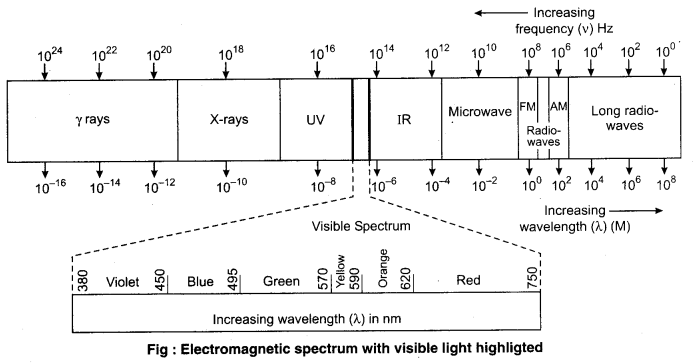
Question 3.
Explain the process of modulation and demodulation. How they are used in message signal propagation?
Answer:
In electronics and telecommunication, modulation is process of varying one or more properties of periodic waveform, called the carrier signal, with modulating signal that typically contains information to be transmitted. Most radio systems in 20th century used frequency modulation (FM) or amplitude modulation (AM) to make the carrier carry radio broadcast.
In general Modulation is a process of conveying message signal. For example, a digital bit stream or an analog signal, inside another signal that can be physically transmitted. Modulation of a sine waveform transforms a narrow frequency range baseband message signal into a moderate to high frequency range passband signal, one that can pass through a filter.
Demodulation : Demodulation is extracting the original information-bearing signal from a modulated carrier wave. A demodulator is an electronic circuit (or computer programme) that is used to recover the information content from the modulated carrier wave. There are many types of modulation so there are many types of demodulators. The signal output from a demodulator may represent sound (an analog audio signal), images (an analog video signal) or binary data (a digital signal).
Differences between modulation and demodulation
- Modulation is the process of influencing data information on the carrier, while demodulation is the recovery of original information at the distant end from the carrier.
- Modem is equipment that performs both modulation and demodulation.
- Both process aim to achieve transfer information with minimum distortion, minimum loss and efficient utilization of spectrum.
- Even though there are different methods for modulation and demodulation process, each has its own advantages and disadvantages. For example AM is used in shortwave and radio wave broadcasting. FM is mostly used in high-frequency radio-broadcasting and pulse modulation is known for digital signal modulation.
Question 4.
Explain with diagram amplitude modulation, frequency modulation and phase modulation.
Answer:
(A) Amplitude Modulation : A continuous wave goes on continuously without any intervals and it is the base band message signal, which contains the information. This wave has to be modulated.
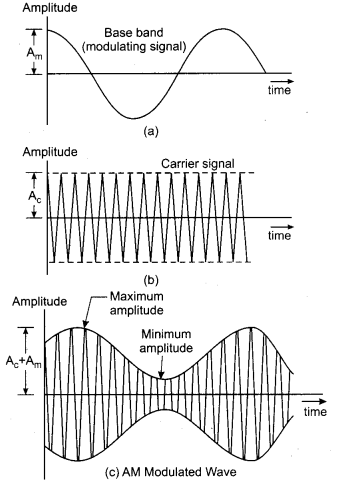
According to the standard principle, “The amplitude of the carrier signal varies in accordance with instantaneous amplitude of the modulating signal.” Which means, the amplitude of the carrier signal containing no information varies as per the amplitude of the signal containing information, at each instant. This can be well explained by the following figures.
The first figure shows the modulating wave, which is the message signal, the next one (b) is the carrier wave which is a high frequency signal and contains no information while the last one (c) is the resultant modulated wave.
It can be observed that the positive and negative peaks of the carrier wave, are interconnected with an imaginary line. This line helps recreating the exact shape of the modulating signal. This imaginary line on the carrier wave is called as envelope. It is the same as that of the message signal.
(B) Frequency Modulation : In telecommunications and signal processing, frequency modulation (FM) is the encoding of information in a carrier wave by varying the instantaneous frequency of the wave. This contrasts with amplitude modulation, in which the amplitude of the carrier wave varies, while the frequency remains constant.
In analog frequency modulation, such as FM radio broadcasting of an audio signal representing voice or music, the instantaneous frequency deviation, the difference between the frequency of the carrier and its center frequency, is proportional to the modulating signal.
Advantages of FM : The big advantage of frequency modulation is its noise reduction ability, because most of noise is appeared as additional amplitude and in FM the amplitude of signal is hold-fixed. In FM, recovered voice depends on frequency not on amplitude. Hence the effects of noise are minimized in FM.
FM bandwidth covers all the frequency range which human can hear. Hence FM radio has better quality of sound in comparison with AM radio.
Disadvantage of FM
At higher frequency, FM modulated signal pass through the ionosphere and do not get reflected. Hence FM has lesser coverage compare to AM signal.
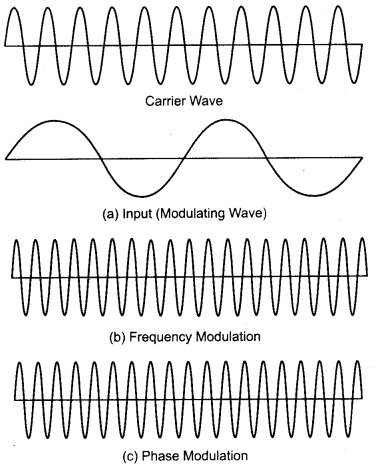
(C) Phase Modulation : Phase modulation (PM) is a modulation pattern that encodes information as variations in the instantaneous phase of a carrier wave. The phase of a carrier signal is modulated to follow the changing voltage level (amplitude) of modulation signal. The peak amplitude and frequency of the carrier signal remain constant, but as the amplitude of the information signal changes, the phase of the carrier changes correspondingly. The analysis and the final result (modulated signal) are similar to those of frequency modulation.
Phase modulation is widely used for transmitting radiowaves and is an integral part of many digital transmission coding schemes that under lie a wide range of technologies like Wi-Fi, GSM and satellite television.
Question 5.
Describe some examples observed in nature of Nanotechnique.
Answer:
The concepts that seeded nanotechnology were first discussed in 1959 by renowned Physicist Richard Feynman in which he described the possibility of synthesis via direct manipulation of atoms.
Nanotechnology is the engineering of functional systems at the molecular scale. One nanometer (nm) is one billionth or 10-9, of a meter. By comparison, typical carbon-carbon bond lengths or spacing between these atoms in a molecule are in the range 0.12 – 0.15 nm and a DNA double-helix has a diameter around 2 nm. On the other hand, the smallest cellular life forms, the bacteria of the genus Mycoplasma are around 200 nm in length. By convention, nanotechnology is taken as the range 1 to 100 nm following the definition used by the National Nanotechnology Initiative in the US. The lower limit is set by the size of atoms (Hydrogen has the smallest atoms, which are approximately a quarter of a nm diameter) since nanotechnology must build its devices from atoms and molecules. Nanofibers are used in several areas and in different products, in everything from aircraft wings to tennis rackets. Inhaling airborne nanoparticles and nanofibers may lead to a number of pulmonary diseases eg. fibrosis
Nanostructers in nature : Average height of a man 1750,000,000 nm is too long compared to human hair with a diameter 50,000 nm. The size of red blood cells and E-coli bacteria are 5000 nm and 2000 nm respectively. Transistor printed an IC is around 90 nm and size of virus is about 50 nm. The width of a typical DNA is around 2.0 nm.
RBSE Class 12 Physics Chapter 17 Numerical Questions
Question 1.
A plane electromagnetic wave travels in free space along the A-direction. At a particular point in space the maximum value of \(\vec{E}\) is 600 volt/meter. What is \(\vec{B}\) at this point? (c = 3 × 108 m/s)
Solution:
We know that the ratio of the amplitude of electric and magnetic field is equal to the velocity of electromagnetic wave.
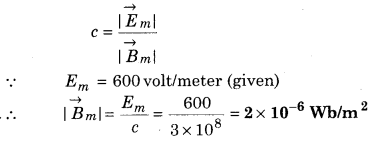
Question 2.
A TV transmitting antenna is 75 m tall. How much maximum distance and area cover by it? Radius of Earth = 6.4 × 106 m.
Solution:
Height of antenna h = 75 m
Radius of the Earth R = 6.4 × 106 m
(i) ∴ Maximum distance of transmitting
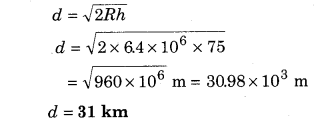
(ii) Maximum area covered by transmitting
A = πd2
A = π (2Rh)
A = 3.14 × 960 × 106 m2 = 3014 × 106 m2
A = 3014 km2